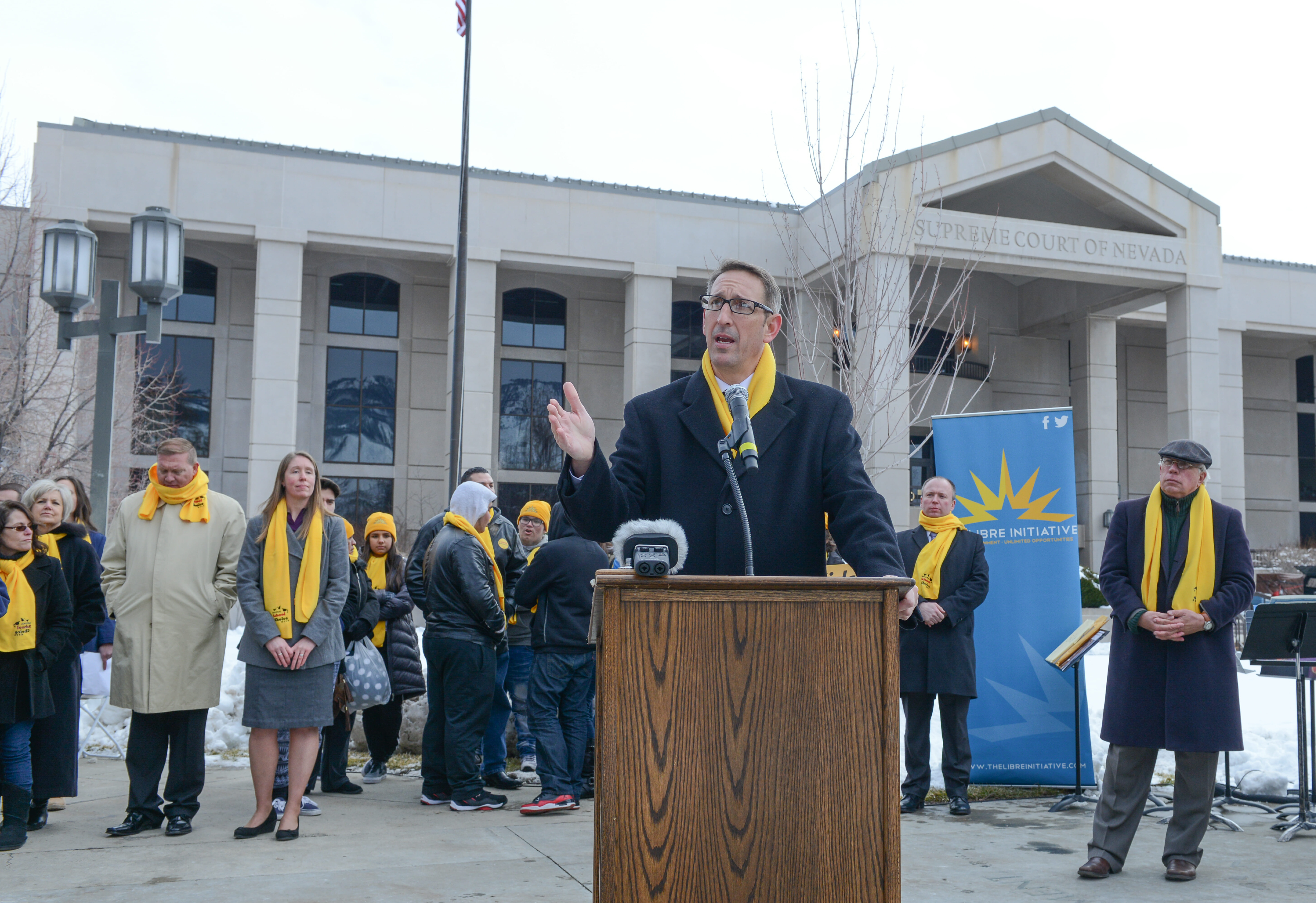Indy Primer: Education Savings Accounts in high demand, but promise to be political flashpoint

By Michelle Rindels and Jackie Valley
A sea of people wearing yellow scarves gathered outside the state Capitol last month to rally for “school choice” — a politically loaded term that has been tossed around more frequently as Nevada mulls a voucher-style program.
The rally likely won’t be the last spectacle regarding the controversial program, which would give parents more than $5,000 in state funds to put toward education-related expenses such as private schooling or tutoring. Advocates say parents should be allowed to make education choices in the best interests of their children. Opponents argue the program threatens to undermine public schools by siphoning state funds out of the pipeline.
The law to create the Education Savings Accounts, as they’re called, has hit legal roadblocks since lawmakers approved it in 2015. If legislators can fix its funding mechanism this session, that could green-light the program. Gov. Brian Sandoval put $60 million toward the program in his proposed budget.
But it’s shaping up to be one of the most divisive issues during the 2017 legislative session now that Democrats — many who opposed the original bill — control both houses. At least 13 Republicans told The Nevada Independent they won’t vote for a budget that doesn’t include funding for the school choice program.
Before the political drama begins, here’s everything you need to know about the program:
What is an Education Savings Account (ESA)?
An ESA is an account established to provide state funds to pay education expenses for qualified students. As the creators envision it, parents can create a tailored education experience for their child -- putting them in private school and paying for speech therapy on the side, or taking some subjects through online learning, others in a homeschool environment and others through private music teachers.
Opponents often describe it as a voucher program, but supporters emphasize that there’s a distinction -- the state isn’t paying schools (including religious ones) directly with state funds as they would through a pure voucher. The money goes into an account that parents control, and it has restrictions on its use.
What’s the origin of the bill?
Republican Sen. Scott Hammond sponsored SB302, which proposed “establishing a program by which a child who receives instruction from a certain entity rather than from a public school may receive a grant of money in an amount equal to the statewide average basic support per pupil.”
The bill specified that those grants would be deducted from funds given to the public school system. The Republican-controlled Legislature passed the bill in the final days of the 2015 session, and Gov. Brian Sandoval signed it into law.
Hammond, a former Clark County School District teacher, was the chief architect behind the bill, which has been called one of the most ambitious school choice laws in the nation. The senator is a founding member of the Somerset Academy of Las Vegas, a group of charter schools.
Who administers the program?
The office of state Treasurer Dan Schwartz.
Who is eligible?
Children are eligible if they are between the ages of 5 and 18 years old, are Nevada residents and have attended a Nevada public school for at least 100 days prior to applying.
Children of active-duty military parents who are serving at a base within the state are exempt from the 100-day requirement and can enroll directly in the ESA program.
Kindergarteners who are over the age of 5 and under the age of 7 by Sept. 30 of the school year in which they enroll are also exempt from the 100-day rule.
Participating students must take a norm-referenced (standardized) test each year.
How much will the student receive?
Qualifying students will receive a grant equal to 90 percent or 100 percent of the state’s basic annual per-pupil spending amount (approximately $5,700). Students with a disability or who come from a household with income less than 185 percent of federally designated poverty level get 100 percent of that. All other students get 90 percent.
What can ESA funds be spent on?
Funds can be used for expenses including tuition and fees for schools and other “participating entities,” textbooks, tutoring, fees for standardized tests, and up to $750 per year in transportation to a participating entity.
How is the money distributed?
Money would flow into each child’s ESA each quarter. The state has considered maintaining the accounts through Benefit Wallet, a company that specializes in health savings accounts.
Established schools and tutors would likely get an electronic payment from an ESA account that would be initiated by a parent using an online portal.
If parents use the money for something like school supplies or services for a student with disabilities, they would make the payment themselves and then submit receipts via the online portal to request reimbursement from the ESA account.
Gov. Brian Sandoval’s budget has included four new positions in the treasurer’s office budget so staff members can review and verify receipts.
Parents can seek a reimbursement for educational goods and services they buy, but cannot use the ESA to directly pay themselves for homeschooling their child. They can, however, be a paid tutor for other children if they meet certain qualification requirements.
What are the treasurer’s fees?
The treasurer’s office will take 3 percent of the money flowing into the ESA program ($1.8 million over two years, if Sandoval’s budget recommendation passes) for administration costs. The treasurer's chief of staff, Grant Hewitt, says he thinks the program will need the full amount at the outset, but will become more efficient and send more money to student accounts in the future.
The accounts may also be subject to payment processing fees of not more than $2.50 a month.
Where is it at in the court process?
The controversial program was hit with two lawsuits in 2015 as the treasurer’s office was gearing up for a Feb. 2016 launch. One from the ACLU argued the program would violate the constitution by devoting public money to “sectarian” purposes when parents paid for religious schools, and that those schools could discriminate against students and staff on the basis of religion, sexual orientation and disability. Another lawsuit brought by parents and supported by Educate Nevada Now argued the program violated the constitution’s call for “a uniform system” of public schools by diverting money away from the public school system.
District courts put the program on hold before it ever disbursed money.
The office of Republican Attorney General Adam Laxalt hired prominent attorney and former U.S. Solicitor General Paul Clement to assist in the state’s defense, and the Supreme Court heard the case in the summer of 2016.
Justices ultimately ruled that the broad outlines of the program didn’t violate the constitution, but the funding mechanism was inappropriate.
ESAs remain on hold unless the Legislature -- controlled by Democrats who generally oppose the program -- decides to fund them.
What would be limiting factors if there’s a scarcity?
While the ESA program didn’t have a funding limit when it was passed in 2015, court developments since then specify that the Legislature must make a conscious decision about how much to budget for the program each cycle. Gov. Brian Sandoval’s proposed budget has designated $25 million for the program in the first year and $35 million in the second year.
If that’s not enough to cover the number of applicants -- it wouldn’t be able to cover everyone if all 8,600 preliminary applicants followed through with their additional verification documents -- the Legislature and/or the treasurer’s office would have to determine limiting factors.
That could mean money is distributed to students on a first-come, first-served basis, or that it’s given to financially needy students first. Hewitt says it’s too early to tell what the factors will ultimately be.
How many applications have come in?
The treasurer’s office has received about 8,600 preliminary applicants since August 2015, and about 405 of those include all the information needed to establish a child’s residency status, school attendance and family income.
It’s unclear how many of the preliminary applicants are still interested in participating in the program or would be eligible for it, since many signed up before the ESA program went through its court challenges.
The treasurer’s office has urged families to promptly start sending in the additional documentation if they’re serious about pursuing their ESA. The office seeks a birth certificate or proof of guardianship for the child, tax returns such as a W-2 to verify income, and a parent’s driver’s license or a utility bill to establish residency.
To verify that the child completed at least 100 days in public school, the office wants the child’s last four report cards or an attendance record letter from the public school.
How many homeschoolers might apply?
The Nevada Homeschool Network has estimated that there are about 7,000 homeschoolers statewide, but only about 60 percent of them would want an ESA. Some homeschooling families view the ESAs requirements - such a standardized testing - as “the camel’s nose under the tent” - a first step toward state regulation of homeschooling. They don’t want to be limited by current or future rules on ESA eligibility.
Where are most applications coming from geographically?
The treasurer’s office released ZIP code data for 6,414 preliminary applications, which shows heavy clusters in the Green Valley and Seven Hills area of Henderson, the master-planned community of Summerlin, the upper sections of North Las Vegas and parts of northwest and southwest Las Vegas. Those locations tend to be known for higher-performing public schools.
More than 100 families living in 89110 in the northeast valley and 89108, a triangular area between Rancho Drive and U.S. 95, also applied for an ESA.
The data, released Jan. 20, did not include about 2,000 applications that had not been entered into the system.
What are the household income levels of the applicants?
Of the completed applications, about two-thirds come from households making less than $50,000 per year, according to the treasurer’s office. Only a fraction of the applications have been have been completed.
This was the income breakdown of those completed applications:
- 245 were from households making less than $50,000 per year
- 52 were from households making $50,000 to 100,000 per year
- 67 were from households making $100,000 to $250,000 per year
- 6 were from households making more than $250,000 per year
